This post may contain affiliate links. Please read our disclosure policy.
This recipe for mock Better Batter all purpose gluten free flour blend works exactly like the original. If you can't buy it, you can make your own.
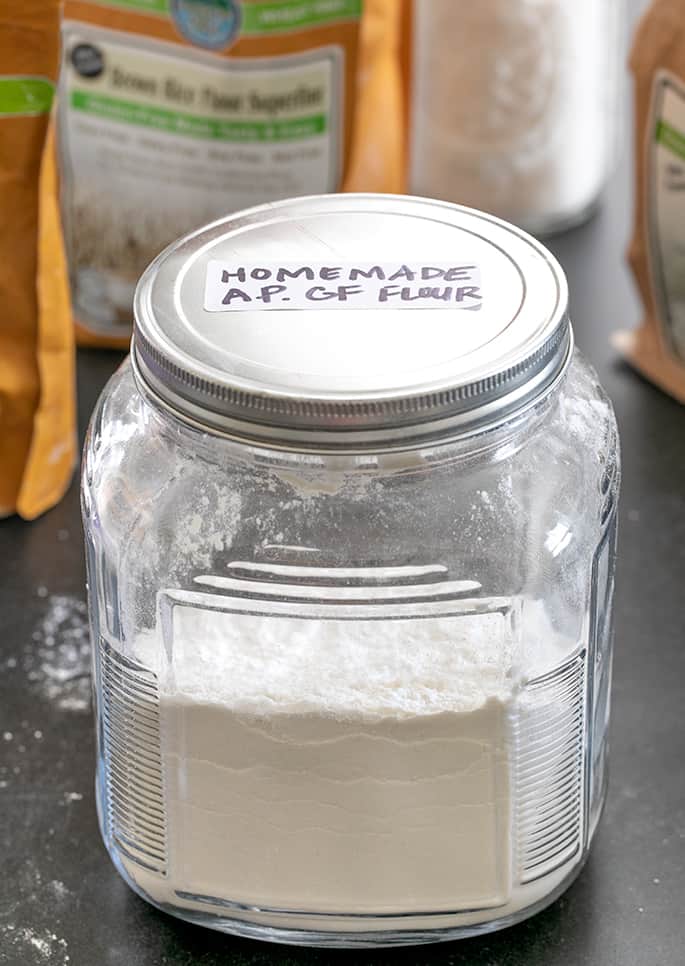
Table of Contents
- Use this gluten free blend wherever my recipes call for an “all purpose gluten free flour”
- The myth of a “cup for cup” gluten free flour
- You must measure by weight to build a gf flour blend
- How to use the formula for making this all purpose gluten free flour blend
- All purpose gluten free flour mock Better Batter: Ingredients and substitutions
- How to make mock Better Batter, the all purpose gluten free flour blend
- Mock Better Batter | All Purpose Gluten Free Flour Blend Recipe
Use this gluten free blend wherever my recipes call for an “all purpose gluten free flour”
If you've come here looking for all purpose, gluten free flour blends, you've come to the right place. Even though I had long sworn off blending my gluten free flours, I've now come around entirely.
I have even created a bunch of infographics for my best all purpose gluten free flour blends for easy, at-a-glance reference. All the details about those rice-based gluten free flour blends (Yes! Generally, rice is gluten free) are on that page, but here we can spend a bit more time talking about one of those blends: my mock Better Batter gluten free flour mix. The blend is made from brown and white rice flour, tapioca starch/flour, potato starch/flour, xanthan gum, and powdered pectin.
I've tested this blend in many of my recipes, like pizza, cookies, and muffins, and haven't had a single failure. Since I first shared this recipe in 2012, many of you have made this blend your go-to and can use it without worry.
The myth of a “cup for cup” gluten free flour
Even the founder of Better Batter has told me that while it's very, very close to her blend, it's not a true cup-for-cup replacement for conventional flour.
I don't care what anyone says, including the founder of Better Batter—or the makers of Cup4Cup gluten free flour—there is no such thing as a cup-for-cup gluten free replacement for conventional flour in conventional recipes.
Gluten free baking calls for gluten free recipes: they're different, they need different ratios of wet to dry ingredients, different binders, and different methods.
I've dedicated my working life to making everything as “normal” as possible, but it will never be exactly the same. We took out gluten. It's just different.
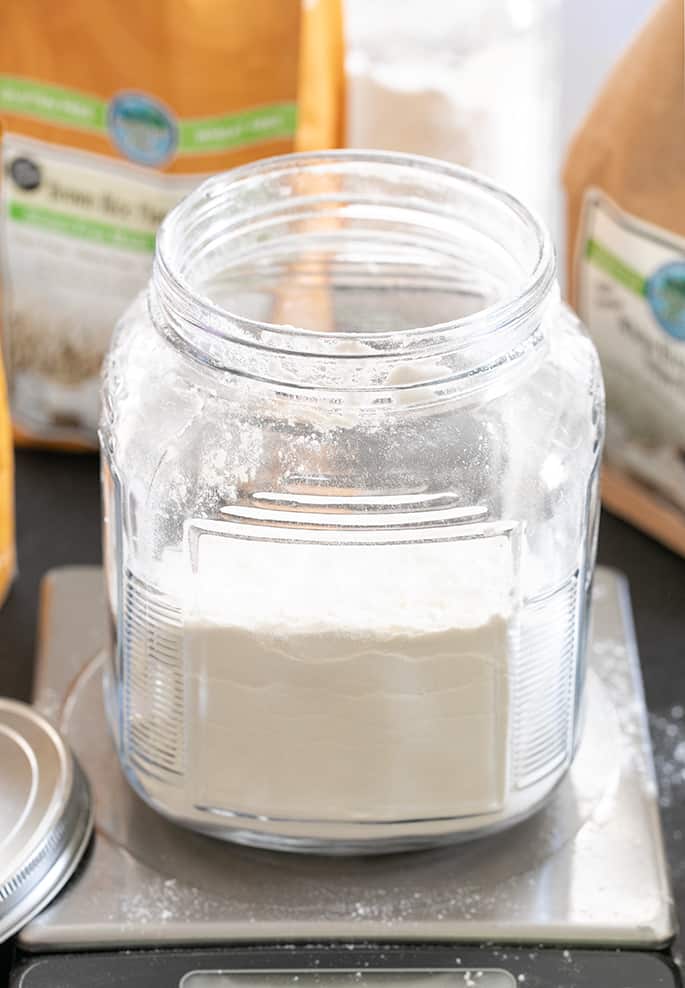
You must measure by weight to build a gf flour blend
You will need a digital kitchen scale. That's an affiliate link, but please feel free to shop around. The Escali brand scale itself is inexpensive, but it will last and last.
The only reason you see a different scale being used in some of my post photos is because I bake all day, every day, and the scale in the photos is easier to clean. OXO makes it, and the metal plate on top is removable for cleaning.
Without the precision of a scale, you simply cannot build a flour blend. In fact, if you find that sometimes your baking is successful and sometimes it isn't without changing ingredients or recipes, but you're measuring by volume, the measurement inconsistencies are likely causing your inconsistent results.
Why volume measurements are inconsistent
I know that many recipe developers direct you to “scoop and sweep” your flours to measure by volume. Fluff up the flour so it's not compacted, scoop with your dry measuring cup, and sweep off the excess on top with a straight edge like the back of a butter knife.
I promise that your results will still be inconsistent. There are a couple of big reasons why.
First, there is no real standardization of dry measurements. Your “cup” might hold a little bit less, mine more. Even when you fluff, scoop, and sweep.
Second, human error is completely unavoidable. One day, you forgot to fluff, or you fluffed more than you did the previous day. Or you have multiple dry measuring cups, and today, you use the one that's similar to mine, but tomorrow you use a different one.
These small differences accumulate, especially when building a flour blend where the ratio of one ingredient to another is all that matters. That's why the ingredients are listed as a percentage of the whole. The individual gram amounts don't matter. The ratios do.
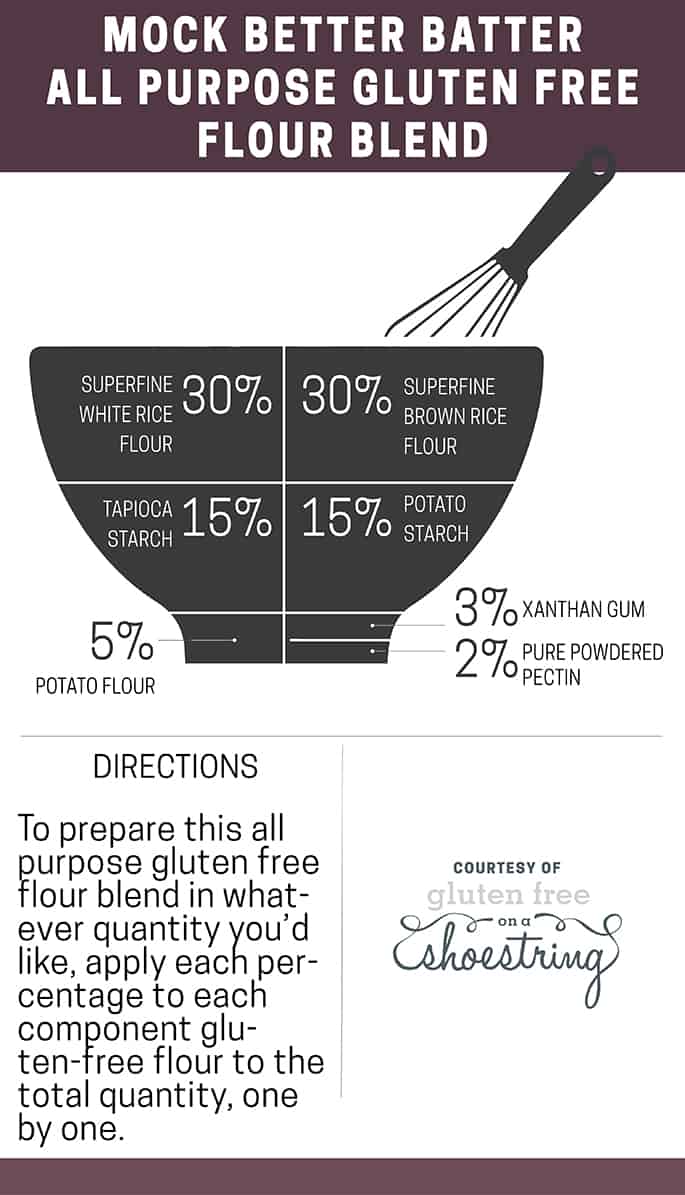
How to use the formula for making this all purpose gluten free flour blend
To prepare each all purpose gluten free flour blend below in whatever quantity you’d like, apply each percentage listed for each individual flour to the total quantity (in grams) of flour that you plan to make, one by one. Add the amounts together, and you'll have the total.
For example, if you wanted to put together 140 grams of flour (which is the proper measurement for “1 cup” of an all-purpose flour blend by volume in my recipes) using the Mock Better Batter Blend, here’s the math:
30% BRF = 30% (or 0.30) x 140 grams = 42 grams superfine brown rice flour
30% WRF = 30% (or 0.30) x 140 grams = 42 grams superfine white rice flour
15% TS/F = 15% (or 0.15) x 140 grams = 21 grams tapioca starch/flour
15% PS = 15% (or 0.15) x 140 grams = 21 grams potato starch
5% PF = 5% (or 0.05) x 140 grams = 7 grams potato flour
3% XG = 3% (or 0.03) x 140 grams = 4 grams xanthan gum
2% PPP = 2% (or 0.02) x 140 grams = 3 grams pure powdered pectin
If you add up all the numbers, it will equal 140 grams (go ahead and check!). So make as much or as little as you like.
Now, I know that many of you will want to tell me that you buy your rice flour from your local ethnic market, and it's fine for you. Or that you grind your own. Or something else entirely. But if you want consistent quality without making a federal case out of it, you need to buy your superfine flours from Authentic Foods.
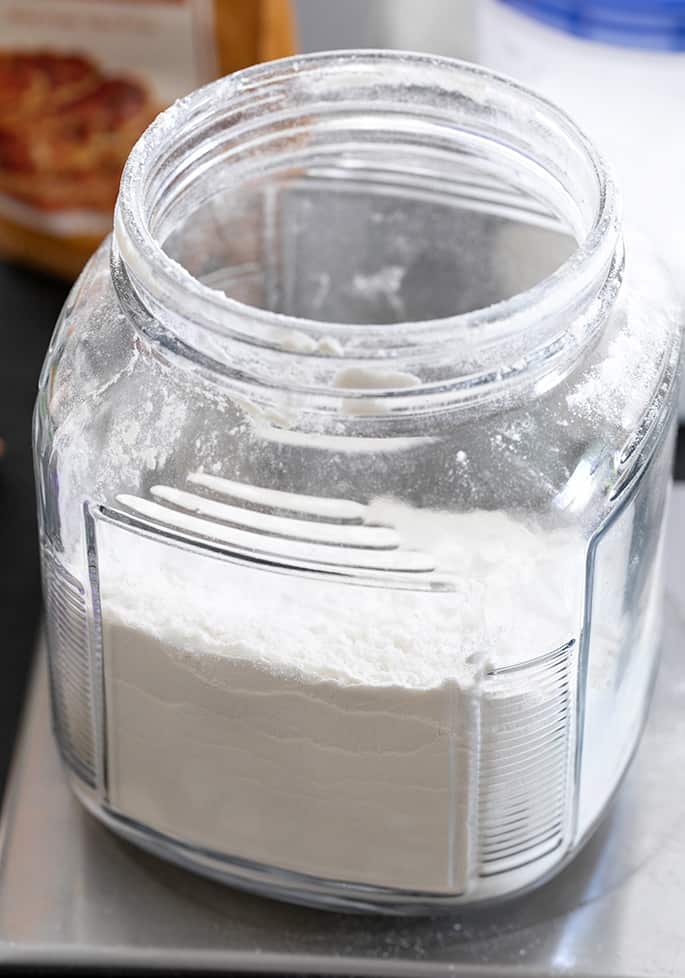
All purpose gluten free flour mock Better Batter: Ingredients and substitutions
Superfine rice flours
We have had a long discussion about superfine rice flour, and even how to blend your own. There is no substitute for rice flour in this blend. If you can't have rice, you should check out my Paleo recipes or my flourless baking recipes.
Superfine rice flour is essential to the most basic gluten free baking. If your rice flour has a harsher grind, like rice flour blends and rice flours from Bob's Red Mill flour, your baked goods will be gritty and often won't even turn out properly. I know Bob's Red Mill is well-priced and readily available, and I wish it were better quality.
Gritty rice flours don't combine fully with the other ingredients in the recipe, essentially changing the entire character of the recipe formula. I always buy Authentic Foods brand superfine rice flour.
I'm also okay with Vitacost.com brand superfine rice flour. In a pinch, I've used rice flour from Nuts.com, and as discussed above, I've made my own by grinding it twice.
Tapioca starch/flour
Tapioca starch and tapioca flour are the same thing. Good to know, right? However, tapioca starch is not the same as cassava flour.
Tapioca starch/flour is the starch from the cassava root. Cassava flour is made with the whole root.
For some reason, tapioca starch/flour tends to vary in quality pretty significantly. Luckily, even good quality tapioca starch is relatively inexpensive, so I buy it in large quantities from Nuts.com.
Unfortunately, there is no substitute for this particular ingredient. It has a unique quality that creates a lovely stretch and pull to the blend.
Potato starch and potato flour
The difference between potato flour and potato starch is similar to cassava flour and tapioca starch. Potato flour is a powder made from whole potatoes that have been peeled and ground into a fine powder. Potato starch is simply the pure starch washed out of potatoes and then dried into a fine powder.
Potato starch can be replaced with cornstarch, but potato flour has no substitute. If you can't have nightshades, I recommend you try my mock Cup4Cup or Better Than Cup4Cup blends, which don't use potato flour.
If you can have but can't find potato flour, you can actually grind potato flakes into a flour and use that. It's the same thing, just in a slightly different form.
Xanthan gum
Oh, the “gums:” xanthan gum and guar gum. Xanthan gum is better to use when heated, like in baked goods. Guar gum is better used when cold, like in a smoothie you'd like to thicken.
Since we are using this blend for baking, xanthan gum is the clear winner. If you can't have “gums” at all, you need a different food blogger for your recipes that call for an all purpose gluten free flour!
Pure powdered pectin
I've probably been asked more questions about the pectin in this blend over the years than anything else. I use Pomona brand pure powdered pectin, which comes with a calcium packet which I just discard. You must use a powder that has a single ingredient: pectin.
Pomona pectin typically is sold in pretty blue boxes with packets in them, which you've probably seen in the grocery store. I've bought it in bulk directly from the company's website, and it lasts forever.
You cannot use “Ball” pectin or anything else that has additional ingredients (like sugar) or is in a gel form. Not only do they add ingredients we don't want, but they have less of what we need: pectin. There is no substitute for this ingredient.
How to make mock Better Batter, the all purpose gluten free flour blend
Mock Better Batter | All Purpose Gluten Free Flour Blend
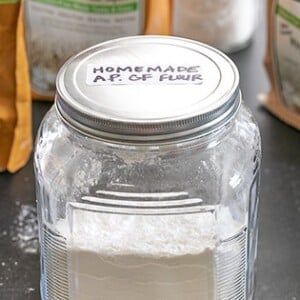
Equipment
Ingredients
- 126 g superfine brown rice flour:, 30% of total
- 126 g superfine white rice flour:, 30% of total
- 63 g tapioca starch/flour:, 15% of total
- 63 g potato starch:, 15% of total
- 21 g potato flour:, 5% of total
- 12 g xanthan gum:, 3% of total
- 9 g pure powdered pectin:, (without the calcium packet!) 2% of total
Instructions
- Place all ingredients in a large bowl, and whisk to combine well. The pectin should be used without the calcium packet. Store in an airtight container at room temperature until ready to use.
- The recipe can be halved or used in multiples easily. Just be sure to whisk fully in a large enough container.
Video
Notes
- Use of lower quality ingredients than those to which I have linked in this post (including the xanthan gum and pectin!) will result in a markedly lower quality product, one that does not behave at all like mine. Proceed at your own risk.
- Measure using a digital kitchen scale. There aren’t proper volume equivalents for some of the ingredients.
- The total cost per 140 gram cup of this D.I.Y. blend is, conservatively, $1.80. The estimate is conservative since it only accounts for shipping costs on the flours from Authentic Foods of $0.12 per cup. Shipping is typically much more expensive than that.
Nutrition
Nutrition information is automatically calculated, so should only be used as an approximation.

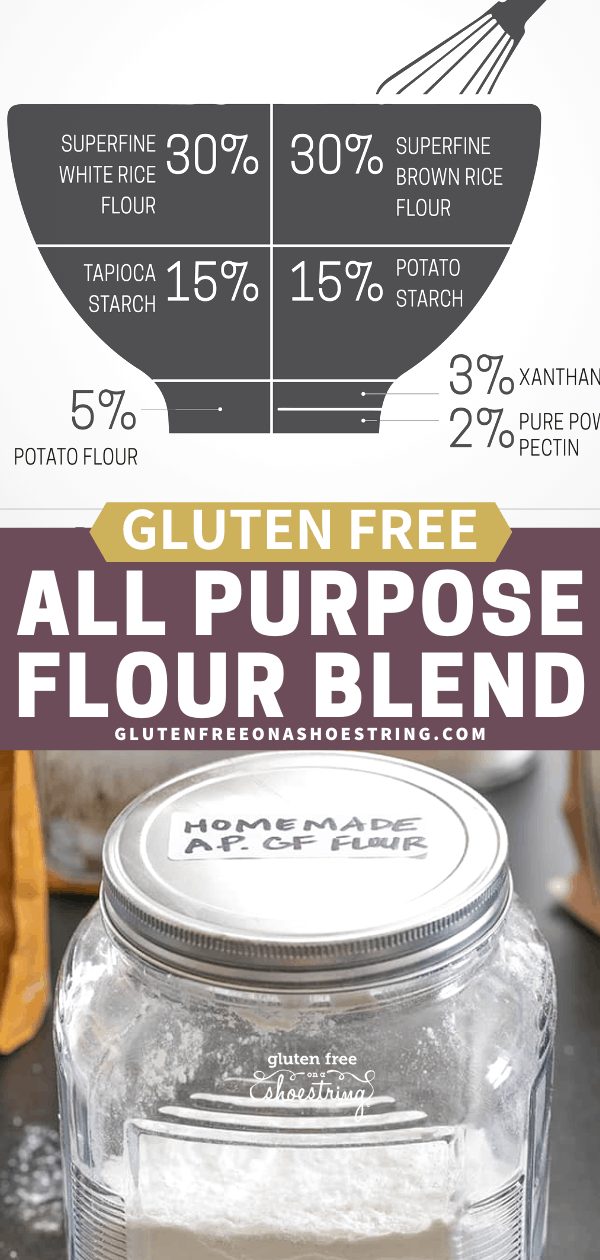
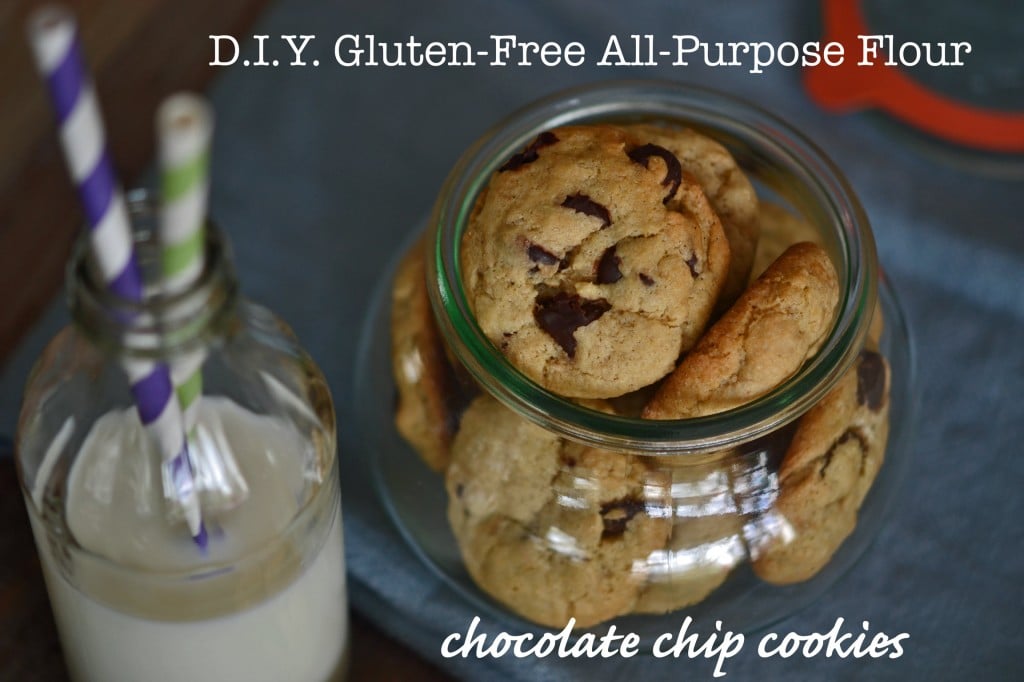
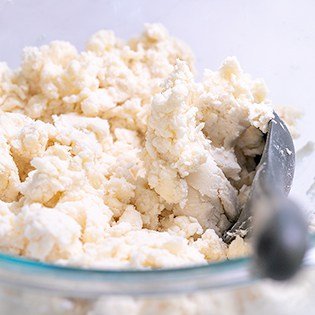

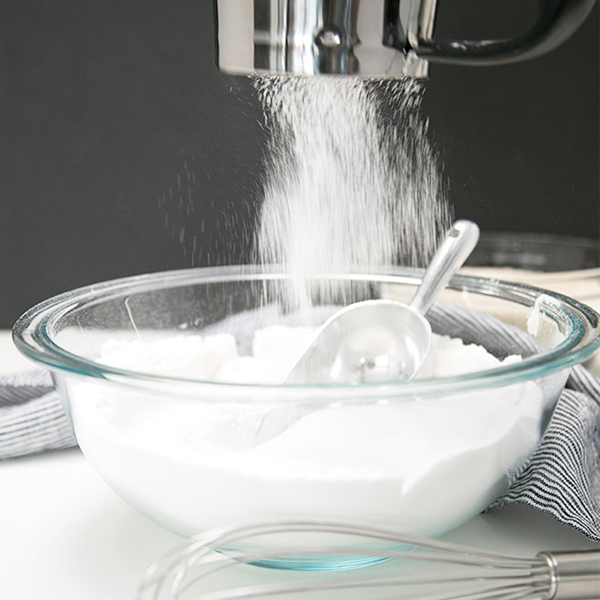
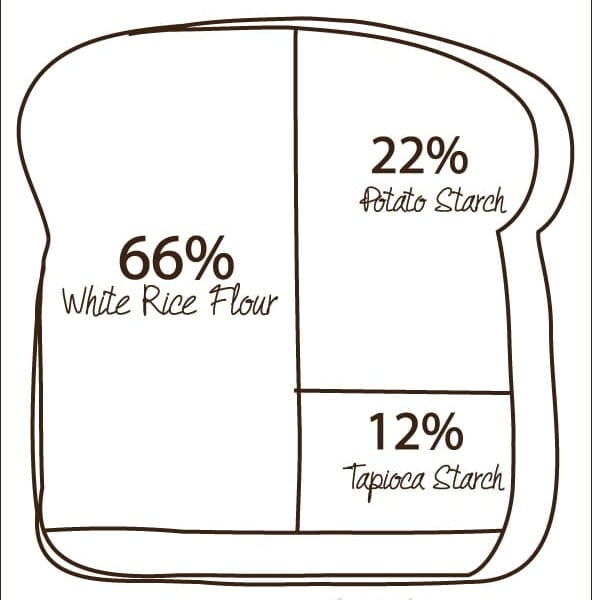









( the Reply button does not work, so I do it this way) RE: “Nancy, you should feel free to try whatever you like, but often readers go their own way and then get angry with me when things don’t work out. I can only give you my advice, and in my experience nothing else works exactly the same. And precision is important in gluten free flour blends.”
Have you tried anything else to replace pectin? I do not know how the flour mix is supposed to behave, since I never tried it, and it is hard to get pure lectin here so I have nothing to compare to when I try Agar Agar or Gelatin or Xanthan or Psyllium Husk (all of which I have). There is only a small amount of pectin in the recipe, but I guess I can not just replace with the exact amount of something else, I have absolutely no experience or knowledge to try something on my own. Any tips or recommendations?
The reply button may not be working because you are using a masked email address to comment.
I don’t think it’s that easy for anyone to get pectin, Nancy. I order mine online, although I have found it in the packets in larger grocery stores. It sounds like you could order it online, but perhaps would rather not. If that is the case, then I recommend that you use one of my other flour blends that doesn’t call for pectin. My Better Than Cup4Cup blend does not call for powdered pectin. Just use the search function to find it, or click on the GF Flours link in this post or at the very bottom of the website. Otherwise, you can always order Better Batter and use their blend itself.
You say pectin can not be replaced with anything else. Why? Pectin is often used to substitute Gelatine, why can we not use that or Agar Agar? What is so special about Pectin?
Nancy, you should feel free to try whatever you like, but often readers go their own way and then get angry with me when things don’t work out. I can only give you my advice, and in my experience nothing else works exactly the same. And precision is important in gluten free flour blends.
Thank you so much, this is excellent.
Could you please give the same chart and scale measurements for your GF Pastry.
From a huge fan all the way from South Africa
Good news, Jeannette! There is an infographic on the gluten free flour blends page that has alllll the blends. You can Pin it to Pinterest and have it as a reference. So glad you like it!
If I wanted to make my own rice flours, does the flour mill you have grind it to superfine consistency? If so what brand is it? TIA
Please click through to that post, Pat! Here’s another link for your convenience: How To Make Rice Flour At Home
Question…I love your recipes but you use butter in most of your recipes. Can I just replace it one for one with coconut oil, either hardened or melted as needed, for the substitute? I don’t want to use any processed ingredients in my food. I also want to limit the starchy GF blends. I discovered a 2/3 oat flour 1/3 tapioca or arrowroot works for every GF recipe. I don’t use sugar substitutes. Coconut sugar is highly recommended for low glycemic and it’s so easy to make it powdered in a coffee grinder
Hi, Barbara, you cannot just make replacements like that across the board. I provide as much information for replacing additional allergens in the “Ingredients and substitutions” section of each post, right above the recipe itself. Everything you eat that isn’t a whole food is processed to some degree.
The only reason I ever blend my own flours, is to say that it’s organic. I am loving Better Batter but I really wish there could be an organic option. Non organic potatoes contain a lot of pesticides =( This should also be part of most peoples healing journey when going gluten free.
Just got all my stuff together and made this, plus a batch for my mother in law. I’m pretty excited……I bought a kitchen scale for the occasion even :)
Hi Nik, lots of work went into this. Thank you. So I have a question. I really like C4C for making your sourdough and a few other things. Is this DIY more like C4C, Better Batter or Jules? Or was your intent to make one DIY that really served all purposes? Or do you plan to hack this DIY to make a bread flour or pastry flour like mix? This DIY is still less expensive than C4C! Thanks! In Vegas with the family. We are leaving today and I am ready to go! I have had enough. We did rent a time share for the week at the Marriott so I have a kitchen. But I miss GF homemade bread. I will be whipping up some sourdough tonight!
This DIY blend is based upon the mock Better Batter mix out there, Kristi! I do plan to hack Better Batter, but I don’t plan to use this blend as the starting point since I don’t plan to make this blend again once I have used up the component rice flours and starches I currently have on hand.
I would love to hear about your time share experience! We are thinking of doing that when come to California in July. :)
xoxo Nicole
I would much rather use pre-mixed even though stores in my area carry these mixes, but I can’t tolerate potato, so I have to mix my own and substitute. It’s a lot of trial and error depending on the recipe what substitute I use.
Is it okay that I really don’t want to mix my own flour? I would much rather trust Better Batter than go through all the work. I’m not a complete purest, I really do love baking and making food from scratch, but mixing my own flours is more work than I’m willing to do at this time. I admire those who mix their own, they are the super-heros of Gluten Free World, but me, I’ll settle for being the side kick this time around. ; )
Oh, JoAnn, it’s not only okay. I’ll join you there. And I personally don’t think you have to blend your own flour to be a superhero. I have zero plans to go forth blending my own all-purpose flour!
xoxo Nicole
I’m with you, JoAnn! No mixing my own flours here, either. So glad Nicole introduced me to Better Batter, that and some Jules and I feel pretty well set. Kind of reminds me of the days when I could have made my own baby food — I admire those who do, but not interested in doing it myself.
Anneke